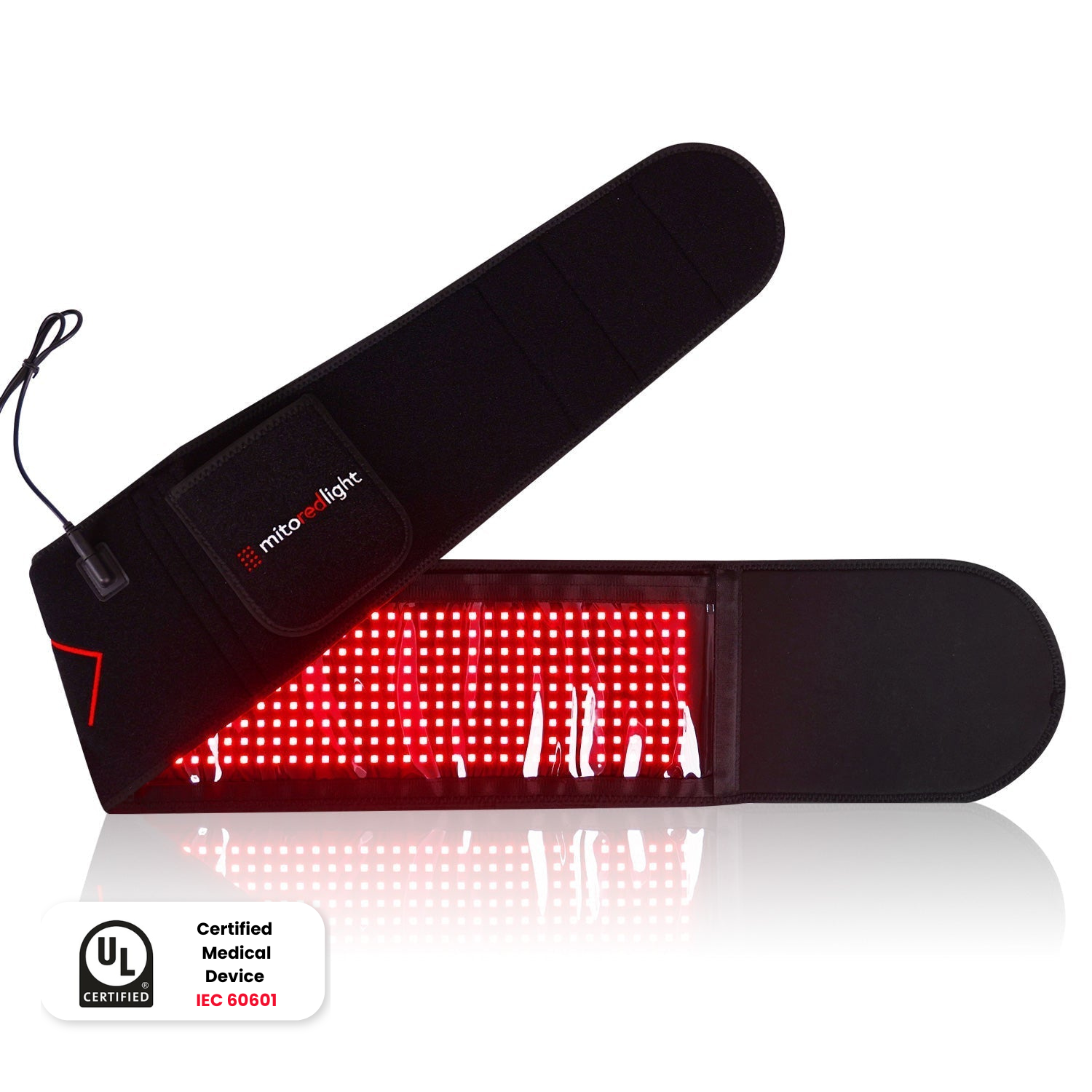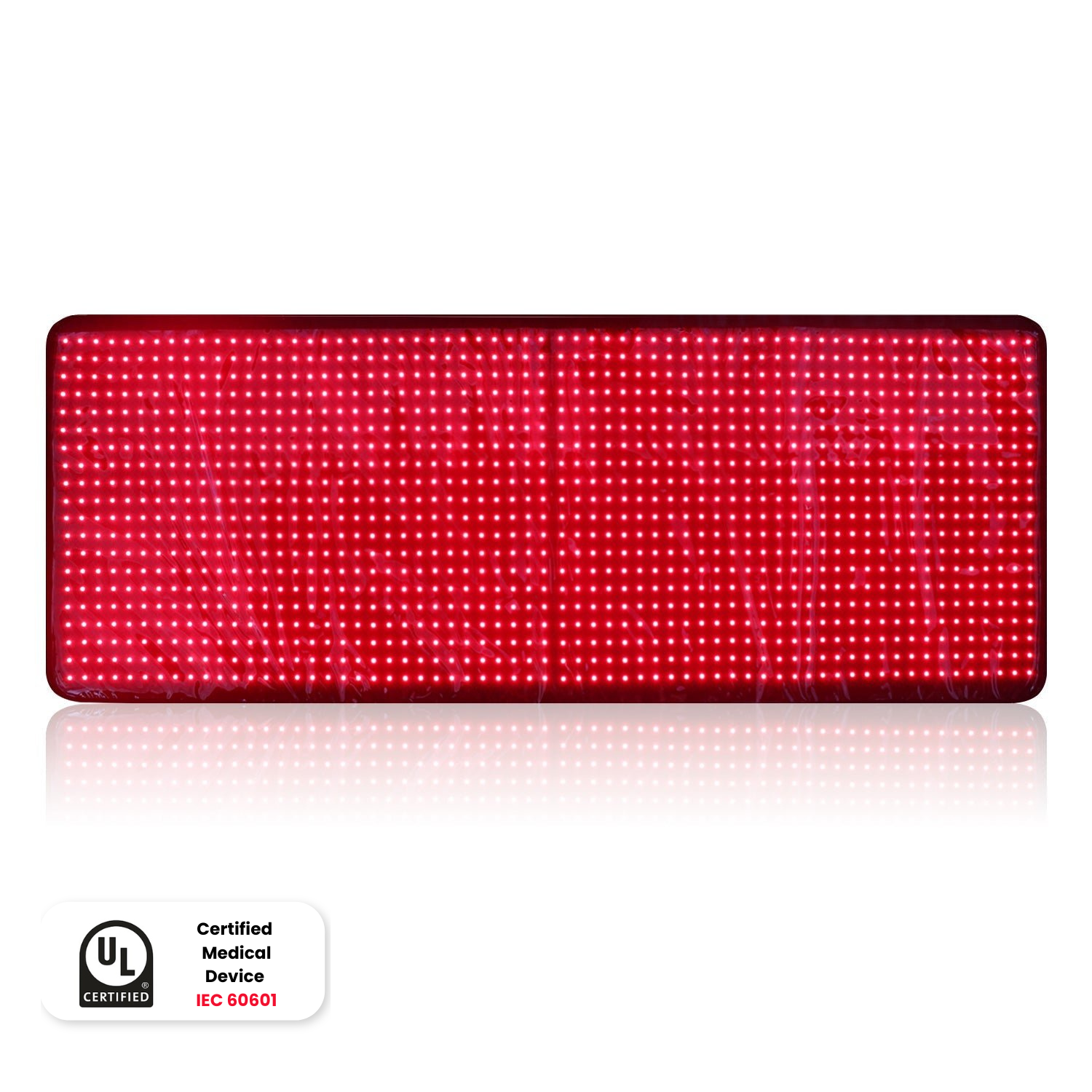DISCLAIMER: Mito Red Light devices are Class II wellness devices aimed at affecting the body through topical heating and supporting cellular function. The information provided in this article and on this site is for educational purposes only and is not intended to imply effectiveness of Mito Red Light devices for any specific application. The information provided in this article and on this site is not intended to diagnose, treat, cure, or prevent any disease, is not a substitute for consultation with a licensed medical provider and should not be construed as medical advice. Click here to read our article on potential contraindications of red light therapy..
Table of Contents
- What Causes Jet Lag?
- Symptoms of Jet Lag
- Your Circadian Rhythm
- Light Affects Your Sleep Cycle
- Preventing Jet Lag
- Managing Jet Lag Once You Arrive
- Red Light Therapy for Jet Lag
- Tips for Traveling with Red Light
Overcoming Jet Lag with Red Light Therapy
Have you ever traveled only to find yourself struggling with the difficulties of jet lag once the trip is over? As anyone who has experienced jet lag knows, adjusting to a new time zone can be unpleasant, making you feel tired right when you want to be feeling at your best. Whether it is performing better at work or getting more out of your vacation, effectively treating or preventing jet lag can help you to feel better.
There are many natural tips and tricks that you can use to offset jet lag and feel better while you travel.
What Causes Jet Lag?
Jet lag is a temporary sleep problem that travelers experience when they cross multiple time zones rapidly. Crossing a single time zone is unlikely to cause it. International travel is a major cause of jet lag, as you’ll generally have to cross several time zones; however, even traveling across the country can cause it.
Jet lag is primality caused by the disruption of the body's internal clock, called the circadian rhythm. This natural cycle regulates many of your physiological processes, including sleep-wake cycles, hormone secretion, and body temperature. Misalignment between your body's internal clock, or circadian rhythm, and the local time at your destination cause fatigue and other symptoms of jet lag until your body readjusts to the new time zone.
People sometimes confuse jet lag with travel fatigue. Travel fatigue is tiredness caused by travel, not by changes in time zones. It may result from factors such as long hours of sitting in confined spaces, dehydration, or changes in cabin pressure during a flight. While travel fatigue can exacerbate the symptoms of jet lag, it is different from this condition.
Symptoms of Jet Lag
The severity of jet lag depends on several factors. These include:
- The number of time zones crossed
- The direction of travel (eastward travel tends to cause more severe jet lag than westward travel)
- Individual susceptibility
- Age (older individuals may experience more severe symptoms
While the severity and types of symptoms vary for each person, some common symptoms of jet lag include:
- Sleep disturbances - Insomnia or waking up during the night are common sleep-related symptoms of jet lag as your body tries to adjust to sleeping while it is used to being awake. You may also experience excessive sleepiness during daytime hours, especially during hours when your body is used to sleeping.
-
Fatigue - Daytime drowsiness, lethargy, and a general lack of energy often occur due to sleep disturbances caused by jet lag.
Cognitive difficulties - Disrupted sleep caused by jet lag can affect mental performance, making it difficult to concentrate, remember things, or function at your usual level. - Mood changes - Irritability, mood swings, or mild depression can result from sleep disruptions and altered hormone patterns from changes in your circadian rhythm.
- Gastrointestinal issues - Your circadian rhythm can affect your digestion, causing symptoms such as constipation, diarrhea, or an upset stomach, while your body adjusts to the new time zone.
- Headaches - Some people may experience headaches as a result of the changes in sleep patterns and hormone levels associated with jet lag.
While the severity and duration of these symptoms can vary from person to person, they usually improve within a few days as your body adjusts to the new time zone. Implementing strategies to help your body adapt to the new environment, such as gradual pre-travel sleep adjustments, exposure to natural light, maintaining a regular sleep schedule, and using natural sleep aids, can help mitigate the effects of jet lag.
Your Circadian Rhythm
Your circadian rhythm is the internal biological process that regulates your sleep-wake cycle over a 24-hour period. It is often referred to as your "body clock" and is primarily influenced by levels of exposure to light.
The circadian rhythm influences several physiological and behavioral processes, including sleep patterns, hormone production, body temperature, and metabolism. It plays a major role in determining when you feel alert and awake or when you feel sleepy and ready for rest. Your circadian rhythm follows a 24-hour cycle, aligning with the natural light-dark cycle of the day.
Light Affects Your Sleep Cycle
Of all the things that affect your circadian rhythm and sleep cycle, light has the greatest influence. Subconsciously, your brain evaluates the amount of light you are seeing and uses this information to regulate your internal body clock.
While the intensity of the light plays a major role, the type of light is also very important. High-energy light, like ultraviolet or blue light, tells your brain that it is time to be awake. This kind of light is a large component of sunlight, helping your body to stay awake while the sun is up.
Orange and red light doesn’t have the same effect. This type of light is more associated with sunsets, sunrises, and light from fires, which was the major light source used during the night throughout most of human history. Advances in screen technology over the past few years have led to nighttime settings, where the screen colors can be shifted to produce less blue light and more orange and red light. This setting helps people avoid insomnia caused by using screens at night by shifting the wavelengths of light they are exposed to. Differences in the intensity of light and the timing of exposure to different types of light both contribute to the changes that jet lag makes to your sleep cycle.
Preventing Jet Lag
While it might not be possible to completely prevent jet lag, there are steps that you can take to at least reduce the impact that it will have on your sleep and well-being. Taking these steps before and during your travels can help prevent jet lag.
- Adjust your sleep schedule before traveling - Shifting your sleep schedule to be closer to the time zone of your destination can help reduce the effects that you will see when you actually change time zones. Adjusting your schedule beforehand can help minimize the effects of jet lag.
- Stay hydrated - Hydration can impact your sleep and overall well-being. This effect doesn’t impact you a lot normally but can during jet lag. Drink plenty of water before, during, and after your flight. Avoid excessive consumption of alcohol and caffeine, as they can dehydrate you and disrupt your sleep patterns.
- Sleep well before traveling - Being well-rested before you travel can help you adjust more quickly. Using sleep aids, like red light therapy or melatonin, can help ensure you are well-rested before your flight.
Managing Jet Lag Once You Arrive
While you can help prevent jet lag, there are also several things that you can do to manage jet lag once you arrive at your destination.
- Adjust to local time - As soon as you arrive at your destination, adjust your activities to the local time zone. Eat meals and engage in activities according to the local schedule, even if you feel tired. This helps your body adapt more quickly to the new time zone.
- Get sunlight and stay active - Expose yourself to natural sunlight as much as possible during the daytime, as this helps reset your circadian rhythm. Engage in physical activity during the day to stay awake and active, which can also help.
- Consider melatonin at night - Melatonin is an important sleep hormone that regulate your sleep-wake cycles. Taking a melatonin supplement a few hours before bedtime may help you adjust more quickly.
- Avoid excessive napping - While it may be tempting to take long naps when you feel tired, try to stay awake when it isn’t time to sleep. Napping can make it take longer to adjust to new sleep times.
Red Light Therapy for Jet Lag
Red light therapy is a popular therapy for helping people sleep better. Several studies have shown that using red light therapy improves the quality of sleep and naturally stimulates melatonin production. A study published in the Journal of Athletic Training followed 20 female athletes who used red light therapy for two weeks. The study found that red light therapy increased melatonin levels and improved sleep. Another study showed that using red light therapy increased daytime alertness and improved people’s circadian rhythms.
While not much research has been done on using red light therapy specifically for jet lag, existing research does support several uses of red light therapy for jet lag-related problems:
- Red light therapy can help promote sleep and restfulness prior to traveling
- Red light therapy can improve daytime alertness
- Red light therapy can help stabilize the circadian rhythm
- Red light therapy in the evening can stimulate melatonin production, helping improve sleep
While red light therapy is completely natural and non-invasive, it also does not contain high-energy light that can disrupt your circadian rhythm if used in the evening. Red light therapy can be a valuable tool for any savvy traveler.
Tips for Traveling with Red Light
Here are our top tips for traveling with your red light therapy panels:
- Check voltage compatibility - If you are traveling internationally, you will need to either use a panel compatible with the voltage in the country you are traveling to or use a voltage converter.
- Choose a portable panel - Use a lightweight and compact red light therapy panel for travel, as it will be easier to carry and transport.
- Protect the panel during transit - Invest in a protective case or bag for your red light therapy panel to prevent damage during travel. You can also consider using bubble wrap or foam padding to add an extra layer of protection.
- Remember any accessories - Accessories such as protective glasses, the power cord for your panel, or stands for your panel can be easy to forget. Always double check you have any important accessories when packing.
- Plan your sessions - During travel, your schedule is typically different than normal. Figure out beforehand the best time and place to use your red light therapy panel during your trip. Consider privacy and convenience factors when planning your session times.
At Mito Red Light, we provide a variety of red light therapy products - we have products which are fantastic for red light therapy at home as well as products that that are ideal for travel. We welcome you to review our selection of red light therapy devices or to contact us at +1 866-861-6486 (MITO) or at info@mitoredlight.com.
Related Articles:
Red Light Therapy When You're Sick: How It May Help
Supporting Sinus Wellness and Immune Health with Intranasal Light Therapy






























